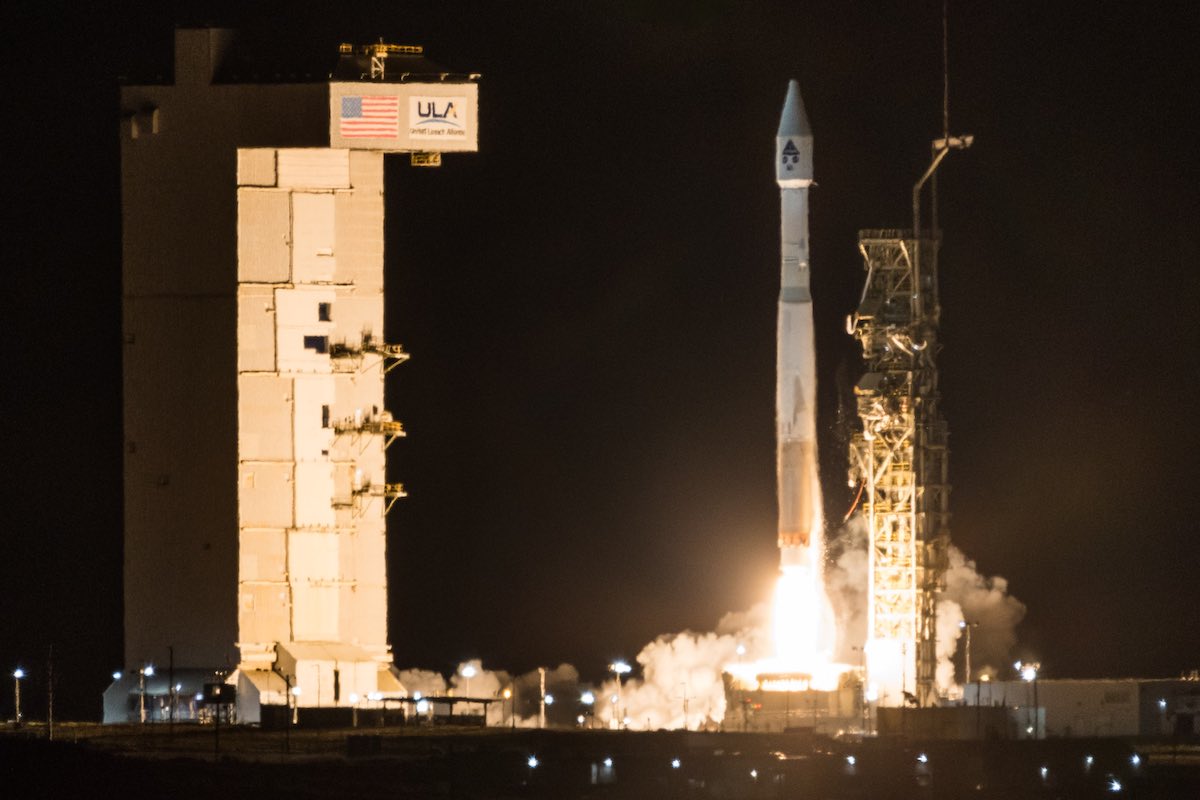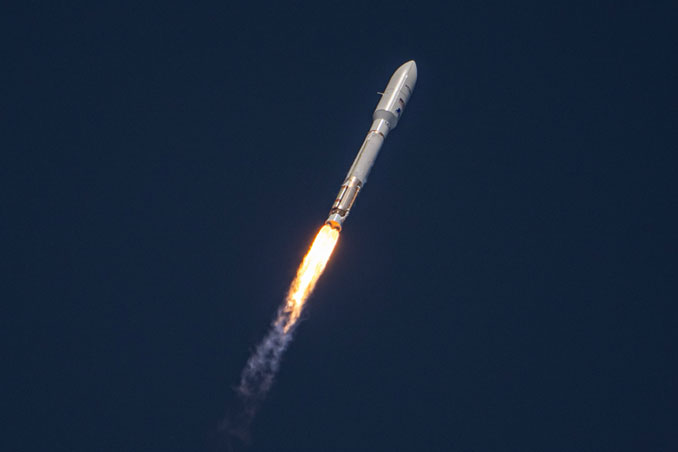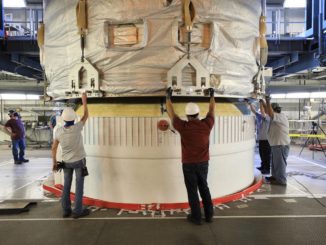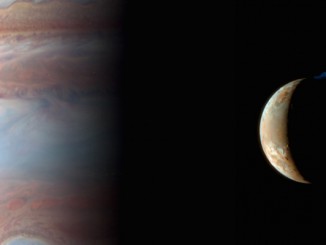
United Launch Alliance entered an important new era for the company with the debut of its Vulcan rocket in early January. The flight was one that was highly anticipated by those both inside and outside ULA and, by all metrics, it was a highly successful mission for ULA.
To mark a month after this inaugural launch, Spaceflight Now sat down with ULA President and CEO Tory Bruno for a discussion about that first certification flight and the year ahead for the company and the rocket.
“This was the cleanest first flight I’ve ever seen. I’ve personally been involved with about three dozen of them,” Bruno said. Prior to his time with ULA, Bruno was the vice president and general manager of Lockheed Martin’s Strategic and Missile Defense Systems.
Bruno was among the launch team on console during the countdown, which was run from the Advanced Spaceflight Operations Center (ASOC) at Cape Canaveral Space Force Station. He said the lack of issues during the countdown threw him for a loop at times.
“It was a very clean countdown. Not an exaggeration, true story, there’s probably 25 minutes or so, I’m sitting on console, silence and I thought my headset was busted,” Bruno said. “I’m like, ‘Maddie, find IT, my headset is broken.’ They come back, ‘No, Tory, there’s literally nothing happening. It’s just that quiet.’”
Bruno said the only issue came towards the end of the roughly 320-second first stage burn of the Vulcan booster: it ended about 1.2 seconds early. He described that as a thermal modeling issue where the last bit of propellant that was moving through the feed line was warmer than anticipated, which triggered the shutdown.

“That was less than a sigma, like 7/10 of a sigma in performance, which would be well within flight-to-flight variation. So, that is a post-flight observation,” Bruno explained. “Obviously, we knew it did that in real time. Afterwords is when we understood it was a thermal modeling issue.”
Bruno said the likely solution will be to adjust the amount of propellant reserve to account for that. He said that work will be done in time, but that it isn’t a pressing issue for their next several flights.
He said while that was the only issue of note, they will continue reviewing the data through the end of February. The reason for that is because with data handoffs that happen between ground stations during flight, there are pieces of the puzzle that need to be fitted together in a thorough, post-flight analysis.
“Over time, all this other data comes in, it gets cleaned up, it gets synchronized in time and events because obviously data you collect in Guam versus real time data down from TDRSS (Tracking and Data Relay Satellite System) is not going to be exactly in the same time reference. So you have to do all of that manually and then you comb through it,” Bruno explained.
“So, that’s why it’ll take until then. They haven’t found anything yet. It’s just literally the cleanest first flight I’ve ever experienced. It was like the 90th Atlas, not the first Vulcan.”
Dream Chaser and Cert-2
With the first flight of Vulcan now largely in the rearview mirror, the ULA team is pressing ahead with the second certification mission. The payload is Sierra Space’s Dream Chaser spaceplane on a cargo supply mission to the International Space Station.
Bruno said they don’t need to wait for the conclusion of the data review to continue the momentum on this next mission.
“We’ll just continue to build and ship and transport and be ready. We’ll do that in parallel because it’ll finish up pretty soon,” Bruno said. “We’re probably 20, 25 days away from completely finishing every last little bit of data review. So, no reason to wait for that. We’ll work in parallel.”
When Bruno spoke with Spaceflight Now on Jan. 31, he said that both the Vulcan booster and the Centaur 5 upper-stage were built and that the Blue Origin-built BE-4 engines that power the first stage were out in Texas for testing.
“Once they come through, then we can finish it and we’ll be ready to go,” Bruno said. “And then we’ll be waiting on our payload, which is the way we like it.”
On Feb. 5, Bruno posted to social media, stating that one of the BE-4 engines for the Cert-2 mission inside the rocket factory in Decatur, Alabama. A couple days later he shared an image of the engine as well.
Nothing quite as pretty on a Wednesday morning as a brand new shiny #BE4 rolling over to get installed on the next #Vulcan… pic.twitter.com/NEUvO7VPhK
— Tory Bruno (@torybruno) February 7, 2024
Reaffirming what he previously stated before the Cert-1 launch, Bruno said that as far as Vulcan readiness is concerned, ULA would be prepared to support the Cert-2 launch in the April timeframe. He said because they have two staging areas for rocket integration, that won’t create a conflict with the Crewed Test Flight of Boeing’s Starliner spacecraft, which is targeting a launch no earlier than mid-April.
Meanwhile, up in Sandusky, Ohio, at NASA’s Glenn Research Center, the Dream Chaser spaceplane, dubbed Tenacity, is undergoing environmental testing before it will be shipped down to the Cape to go through final checkouts and cargo loading.
Speaking at a media event before the next stage of testing began, Sierra Space CEO Tom Vice described their excitement at finally reaching this stage.
“We are coming out of years of development, years of hard work, years of resolving really tough engineering challenges that come from revolutionizing the way we do things,” Vice said. “And we are really excited that this year we enter orbital operations for NASA. It is a year that we change how we connect Earth and space.”
National security readiness and West Coast launches
Getting through these two consecutive certification flights are critical for ULA in clearing the vehicle to start flying National Security Space Launch (NSSL) missions.
“[Assured Access to Space] has a new entrant cert. guide that defines those different ways. And when you look through that, you can actually see there’s a variety of ways a launch service provider can certify,” said U.S. Space Force Lt. Col. David Schill, the Space Launch Delta 45 Vulcan Centaur materiel leader, in a pre-produced video regarding the Vulcan Cert-1 launch.
“What ULA has done is they selected an approach, which requires two consecutive, successful launches. And in addition to those two consecutive, successful launches, a government team has technical insight into and acceptance of the system design,” Schill said. “So, that’s really unique in this case and which makes Vulcan special is that deep, technical insight that we have into the program.”

Through five years of NSSL Phase 2 Contract Launch Service Task Order awards, ULA has 48 missions ahead of it that are valued at about $3.1 billion. Among those missions, 47 will be launched using its Vulcan rocket.
The first such mission on deck for Vulcan will be USSF-106, a multi-manifest mission consisting of the Navigation Technology Satellite-3 (NTS-3) and another payload for the U.S. Space Force.
These missions are coordinated through the U.S. Space System Command, which is headquartered at the Los Angeles Air Force Base in California. While SSC said the specific cost of the USSF-106 mission with Vulcan is proprietary information to ULA, it has publicly stated that the mission was part of a two-launch award worth $278.7 million. The other mission in that bundle, USSF-51, is set to launch using ULA’s Atlas 5 rocket as soon as March.
In a joint statement to Spaceflight Now, Col. Doug Pentecost, the SSC’s Deputy Program Executive Officer for Assured Access to Space, and Michael Sanjume, the senior materiel leader for Vulcan Systems and Operations described the timeline following the Cert-2 launch.
“Once ULA has completed their second certification flight (‘Cert-2’), the government will do its final analysis for certification over a few months, allowing for USSF-106 to launch this summer,” they said in their statement.
Between ULA’s three rockets, Pentecost and Sanjume said there are five NSSL missions on the 2024 manifest:
- USSF-106 – Vulcan
- GPS 3-SV07 – Vulcan
- USSF-87 – Vulcan
- USSF-51 – Atlas 5
- NROL-70 – Delta 4 Heavy
USSF-51 and NROL-70 are slated to be the final NSSL missions using ULA’s legacy rockets, according to Pentecost and Sanjume. The latter of the two will mark the final Delta rocket to launch before that line is officially retired.
Bruno said there are important reasons to retire the Delta 4 Heavy, not least of which is the cost savings per launch with Vulcan. But he said it will be somewhat sad to see it’s final flight.
“It’s a beautiful rocket. It’s launched amazing missions. It’s the most metal of all rockets, as I like to say. It sets itself on fire before going to space,” Bruno said. “I just love it and so, we’re all going to miss it. It’ll be bittersweet.”

The final award of NSSL Phase 2 missions last year came as ULA and other launch providers are jockeying for the Phase 3 missions. Those will be split up into two lanes: Lane 1, which opens up opportunities for newer launch companies and smaller rockets and Lane 2, which requires a capability to launch payloads to any and all orbits.
That second lane will have a 60-40 task order split with a carveout for seven missions for a total of up to three providers. Bruno said ULA will compete to win the 60 percent slice of the pie as they did with Phase 2, but said the 40 percent slice is fine as well.
“They’re all interesting missions. There’s a lot more total missions in Phase 3 than there are in Phase 2. So, in terms of business-wise, it’s great to be in either one,” Bruno said. “We are going to go and bid on the ones for Lane 1 for any that we think we’re competitive for and we’d be good for.”
Bruno said that while Lane 1 is intended as a so-called “sandbox” for launch providers, he was told that because of the number of missions that will be in Lane 1, that the government wants bigger players, like ULA, to bid on some of those missions as well.
“I think we’ll scoop up some of these, where there’s an urgent need and we’re especially well-suited and maybe these other players just can’t do it,” Bruno said. “They can bid one at a time on any mission that they are comfortable and have the capability for, which is different than being in Lane 2, where you have to be able to fly everything in order to even bid.”
Looking ahead to Vulcan launches supporting NSSL missions, ULA is continuing work to convert Space Launch Complex 3 (SLC-3) at Vandenberg Space Force Base from an Atlas 5 pad into one for Vulcan.
He said the Phase 3 contract will further increase the need for West Coast launches of Vulcan beyond what’s required in Phase 2.
“There are more missions in that timeframe going out of Vandenberg than there are now. And so, we’re taking advantage of this quiescent period to reconfigure the pad for Vulcan, which is different from what you saw us do out here in Cape Canaveral, where we reconfigured the pad in between Atlas launches and configured it in order to be able to fly either rocket, back and forth,” Bruno said.
“But out at Vandenberg, it’s a hard cut over. The last Atlas rocket’s already gone out of there,” he added. “So, the pad is down and we’re constructing it for Vulcan uniquely. We’ll be flying out of there and there will be more flights in that window of time out of Vandenberg than there are nowadays, obviously before the stop.”

Bruno said this new wave of launches that will be calling upon Vulcan is just one half of the equation for them as they start ramping up the commercial side of their business.
“We’re going to be super busy and our biggest challenge is not worrying about winning these contracts. It’s about ramping up and building all the infrastructure and expanding the factories to keep up with that launch tempo,” Bruno said.
Commercial buildup
The emergence of Vulcan into ULA’s launch fleet begins a key shift for the company. It moves from one focused predominantly on government payloads to one with a roughly 50-50 split with commercial flights. Bruno said the equation is actually tipping slightly more towards the commercial side these days.
He said about 70 percent of their commercial business is driven by their 47-launch contract with Amazon to launch its Kuiper satellite constellation. The tech giant purchased the final nine Atlas 5 flights available as well as 38 Vulcan flights.
“If you asked me today, I would say it’s 48 because we flew their prototype one and two mission as well, which was not originally part of our contract. But they needed us and they needed us in a hurry because those spacecraft go to orbit and they demonstrate certain key technologies for them,” Bruno said. “And it’s to confirm the design path they’re on as they were entering into high-rate production. So it was urgent, if you will.”
Originally, the two satellites were set to fly on an ABL RS1 rocket, which was later switched to be part of the first Vulcan flight. After the announcement of Vulcan’s debut slipped from a May 4, 2023, opportunity, Amazon pivoted to the Atlas 5 rocket they launched on in September.
“It was a five-month integration of flight, which is pretty short. The standard is you order your ride to space two years out. And doing it in five months was pretty challenging,” Bruno said. “And so, we stepped up and we did it for our customer, like a good partner, and I’m glad we did because it was, again, a beautiful mission. But their mission was stellar as well.”

Bruno said once Vulcan starts flying Kuiper missions, it will launch 45 satellites with each flight. Atlas 5 rockets will carry 27 satellites each. Bruno said for these mega-satellite constellations, it’s important to get as many satellites on orbit as quickly as possible.
“They don’t start being useful until you get about 60 to 70 percent of that first shell on orbit. So, you’re building a lot of satellites and you’re spending a lot of money and you’re signing up subscribers, but you’re not providing any service until you break that threshold,” Bruno said. “So, the front end of this for a commercial application, like Kuiper, like OneWeb, anybody, Starlink, is you want to rapidly get them up there and hit that.”
Bruno said the other side of the equation for Amazon or other owners of these mega-constellations is what he described as the “dollar per spacecraft on orbit.”
“The way people would talk about lift in the old days was dollars-per-kilogram, which by the way, was never ever meaningful, until now. Why wasn’t it meaningful? Cause the rocket’s the rocket and every mission that flies does not max out its mass capability, right?” Bruno said.
“But with small satellites in these mega-constellations, you really do fill up the whole payload fairing and fill up your mass capacity on every, single launch. And the more you fly, remember I said dollar-per-satellite, that’s the denominator,” he added. “And so, it has a very powerful effect on the economic attractiveness of the lift part of the equation.”
In order to meet the demand from Amazon and future commercial partners, ULA is going through a large expansion of both its factory in Decatur, Alabama, as well as the support infrastructure along its supply chain.
On the factory side, Bruno said they are putting in a second production line to manufacture the Centaur 5 upper stages and placing them in their finished goods warehouse. They are also in the process of building a second transport barge that will be used alongside the Rocketship.
“We’ve let our subcontract to our ship builder, Bollinger. They’re doing design work right now. Keel will be placed next year. And so, our mighty fleet of one Rocketship will become two Rocketships, so we’re doubling the fleet,” Bruno said. “It’s actually a little bit more than doubling, capability-wise, because it’s a bigger ship.”
Bruno teased that he already has a name picked out for the second ship, but will wait to disclose it at a later date.
He added that at the Cape, the Spaceflight Processing Operations Center (SPOC), where the Vulcan Launch Platform (VLP) was built, is being converted into a second Vertical Integration Facility (VIF). That will allow for two rockets, either an Atlas and a Vulcan or two Vulcans, to be prepped for launches simultaneously. Bruno said that will be operational before the end of 2024.
On the supply chain side, Bruno said that Northrop Grumman is “essentially building a whole other rocket motor fabrication facility for us.” He also noted that Blue Origin’s 200,000-square-foot expansion to its rocket engine factory in Huntsville, Alabama is also nearing completion.
During a May 25, 2023, Huntsville City Council meeting, a proposal to purchase 14.83 acres of land at Cummings Research Park near the current engine factory site was approved. Blue Origin purchased the land for $1,427,378.50, according to Shane Davis, Huntsville’s director of urban and economic development.
Both Aerojet Rocketdyne, the supplier of the RL10 upper stage engines, and L3Harris, which provides the avionics for Vulcan, are increasing their infrastructure as well to support the goal of launching Vulcan 25 times per year.
“We don’t hit the every two week tempo, 25 equivalent per year, until the back half of 2025,” said Bruno. “So, if you were to come into our facilities and talk to our people, you’d hear people talking about 25 in 25.”



